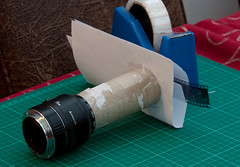decided to build a rig to be used with my A7II instead of buyng a scanner.
This is what i came up with:
Camera will be mounted on a macro rail and on a lab jack. This will allow for adjustment in all directions, so that i can center my sensor over both 120 and 35mm film. Also I will be able to take multiple shots of 120 film to achieve higher resolution if I need it.
Film holder consists of a light diffusing panel on the back and two pieces of black acrylic welded onto it.
Film will be held flat by 100x100mm anti newton glass (in the middle)
It will be backlit by either a flash or a led lamp - I will see what is better
Will try to build it over the weekend and report back with results

This is what i came up with:
Camera will be mounted on a macro rail and on a lab jack. This will allow for adjustment in all directions, so that i can center my sensor over both 120 and 35mm film. Also I will be able to take multiple shots of 120 film to achieve higher resolution if I need it.
Film holder consists of a light diffusing panel on the back and two pieces of black acrylic welded onto it.
Film will be held flat by 100x100mm anti newton glass (in the middle)
It will be backlit by either a flash or a led lamp - I will see what is better
Will try to build it over the weekend and report back with results

Last edited:


















